The crown of thorns plant is a beautiful, evergreen shrub to any home and garden. They are easy to grow and require minimal maintenance.
Crown of thorns plants make for great houseplants, as well as ground cover for shady areas or as part of your garden border.
In this article, learn how to grow crown of thorns plants indoors and outdoors to make them a beautiful addition to your home.
Crown of Thorns Plant Overview
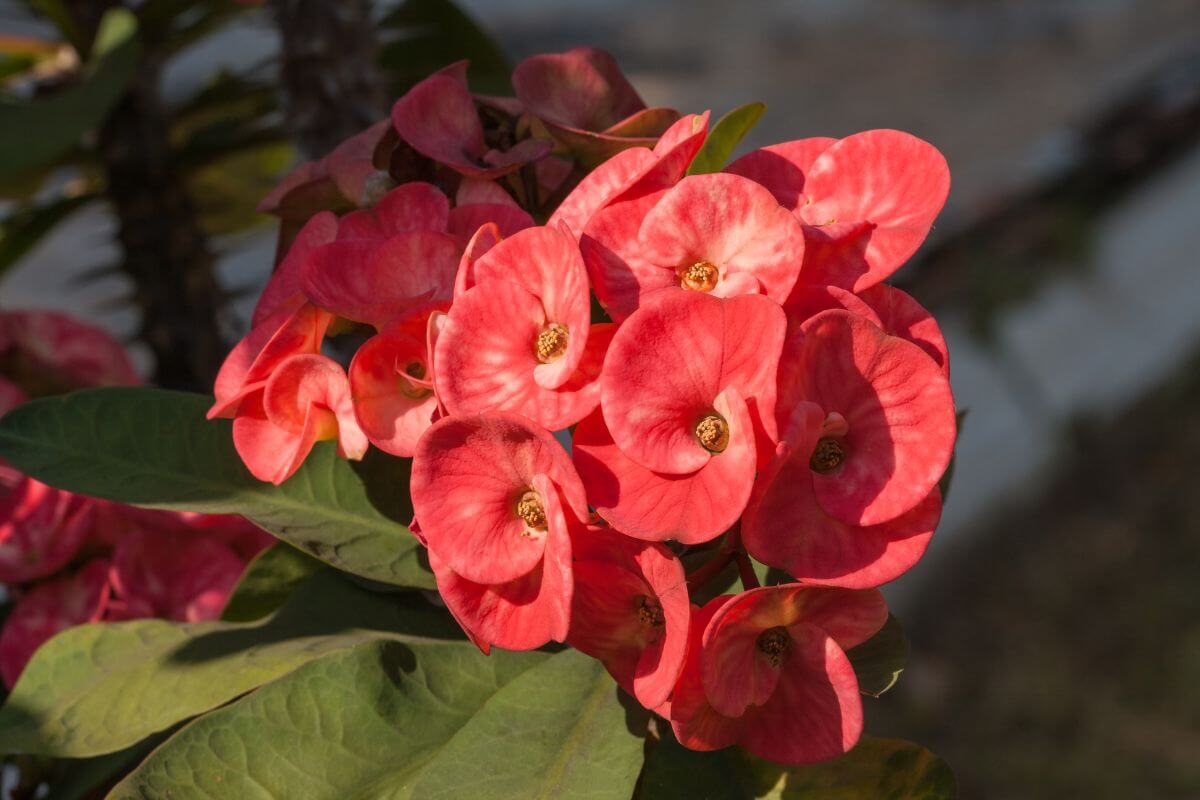
With an unusual common name, the Crown of Thorns plant is known botanically as the Euphorbia milii. It’s a succulent with bright green leaves that can bloom all year long, including when cultivated indoors.
The foliage is lush and thick with black thorns protect the plant’s branches. The stem thorns are actually quite soft when touched, and therefore it won’t be too difficult to work with. Flowers in orange, yellow, pink, white, or red can brighten up your home.
This is a wonderful plant for indoor cultivation. Although a slow grower, it can grow into a bushy shrub reaching from three to six feet tall when cultivated outside. Indoors, it may grow to about two feet.
Apparently, the name of the plant originates in the belief that the crown of thorns placed on Jesus Christ prior to His crucifixion was created with this plant’s stems. In fact, this plant is also called the Christ plant, Christ Thorn plant, or crown-of-thorns plant.
This plant achieved popularity in the Victorian area when Naron Milius brought it to France. The species name “Milli” is to honor this.
While your local nursery or garden center may have a few varieties of crown of thorns, there are many hybrids available as colorful houseplants with varying sizes of blooms.
Several popular hybrids are:
- “Brush Fire Crown of Thorns” – features fleshy, thick leaves and vivid red blooms.
- California Hybrids, including “Saturnus” and “Rosalie” – will have thick stems and quite large flowers. These are often referred to as “Giant Crown of Thorns” and are particularly indicated for outdoor cultivation.
- “Crème Supreme Crown of Thorns” – will flower with creamy white blooms.
- “Short and Sweet Crown of Thorns” – have vivid red blooms and will grow to as much as 18 inches.
Crown of Thorns Plant Care Guide Overview
Native to Africa, this succulent is a perennial plant when cultivated in the USDA Hardiness zones 9, 10, and 11. When cultivated in colder climates, it should be cultivated as a houseplant.
The Euphorbiaceae genus is also drought resistant. It will grow stems that are woody, while leaves tend to grow on the younger parts of the plant. While blooming is normally characteristic of spring and summer, this plant can bloom all year round in the correct environmental conditions.
To check the health of your plant, keep an eye on the foliage. If leaf shedding is limited, it’s probably a normal part of maturation.
However, if all the foliage falls at once, your plant has a problem. That’s often a result of overwatering or lack of drainage. Even though this is a succulent, it can only store a limited amount of water.
Soil for the Crown of Thorns
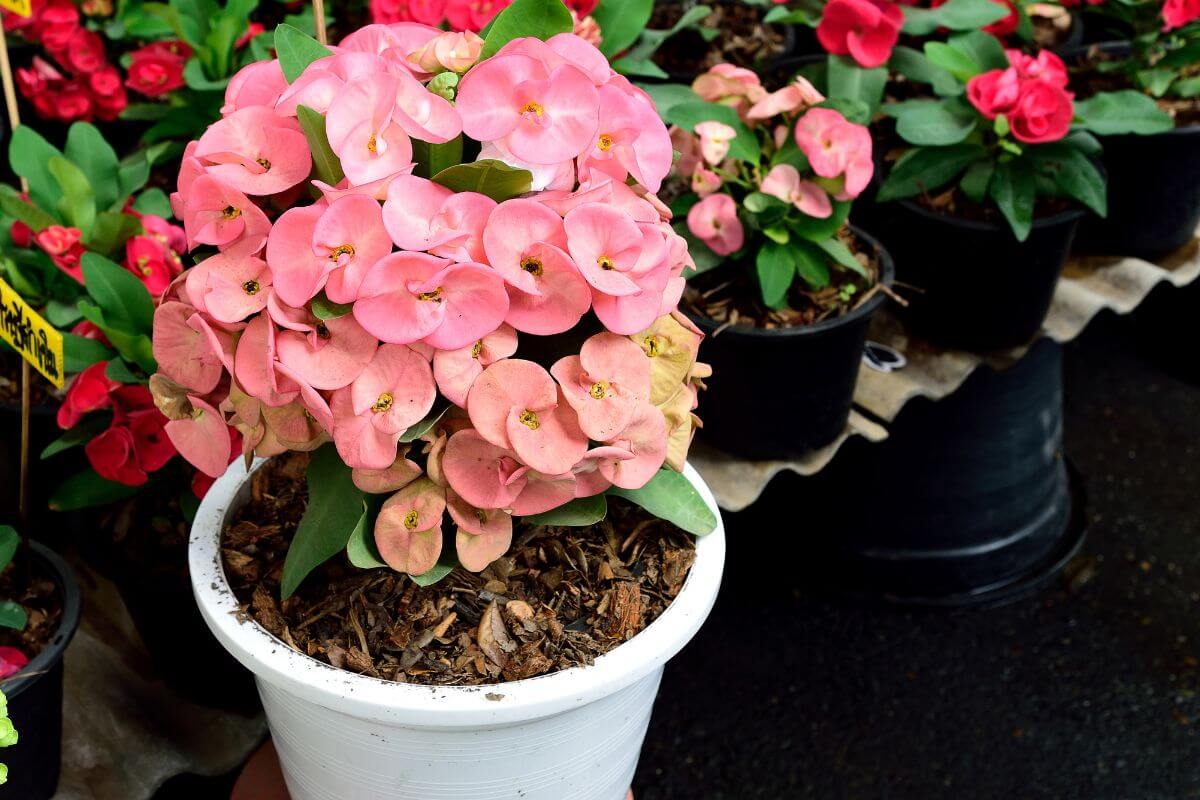
The potting soil mix should be well-draining with a third of perlite added to potting mix. A prepared cactus soil mix will do the job too.
Potting mix needs to be well-draining, so be sure to plant the crown of thorns in a pot or container that is only one to two inches larger than the plant’s root ball. A larger pot will contain excess soil that in turn can retain water, leading to root rot.
Direct Sunlight for the Crown of Thorns
As a blooming houseplant, sun exposure is important. This plant can be said to be hungry for sunlight.
Place it in a location that is bright and sunny, like in or near a west or south-facing window where it can enjoy direct sunlight.
Outdoors, it can be planted in a cactus garden to add color. If however, you reside in an area with hot scorching weather, place your crown of thorns in a zone where it receives shade in the afternoon.
Heavy shade will reduce blooming, so be sure it also gets direct, bright light.
Temperature for the Crown of Thorns
Normal room temperatures between 65° and 75° Fahrenheit are great for the crown of thorns houseplant. If the temperature drops during the evening and night, not to worry as this plant can handle a temp as low as 50° F.
Water and Humidity for the Crown of Thorns
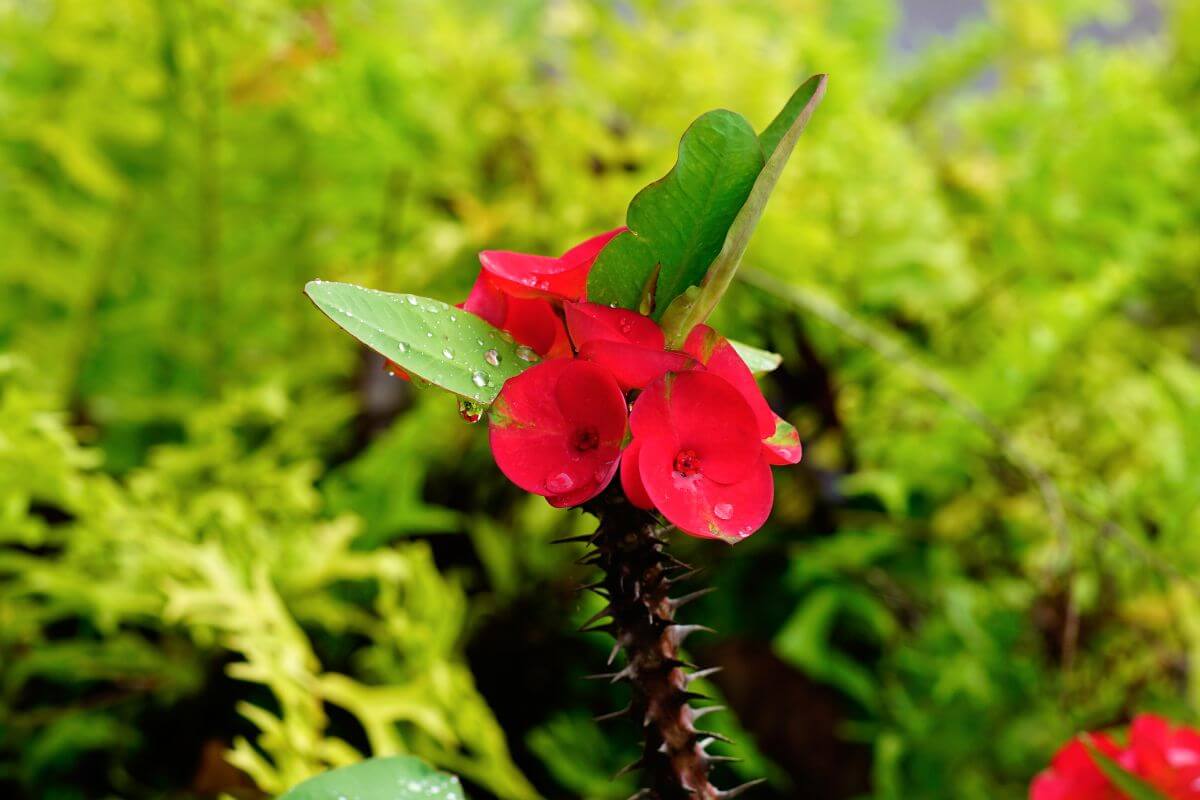
Thanks to its drought tolerance, you can occasionally forget to water and the crown of thorns will survive. If the top inch of the soil bed feels dry, you can water it.
Excess water should always be allowed to drain. Soggy or waterlogged soil will encourage root rot. When it becomes semi-dormant in the winter seasons, watering can be reduced.
It does not require a great deal of humidity, so it will do well in average room temperatures and humidity. If you live in a dry indoor environment, misting leaves can also help.
Tip: This plant does well at the seaside, so try misting with a very weak saline water solution.
Fertilizer for the Crown of Thorns
This is a plant that can survive without feeding. Even so, a bit of diluted fertilizer given sparingly can encourage flowering. Your fertilizer should not have boron, as this plant is sensitive to it.
A slow-release fertilizer is an option if you do want to encourage flowers.
Pruning and Plant Maintenance for the Crown of Thorns
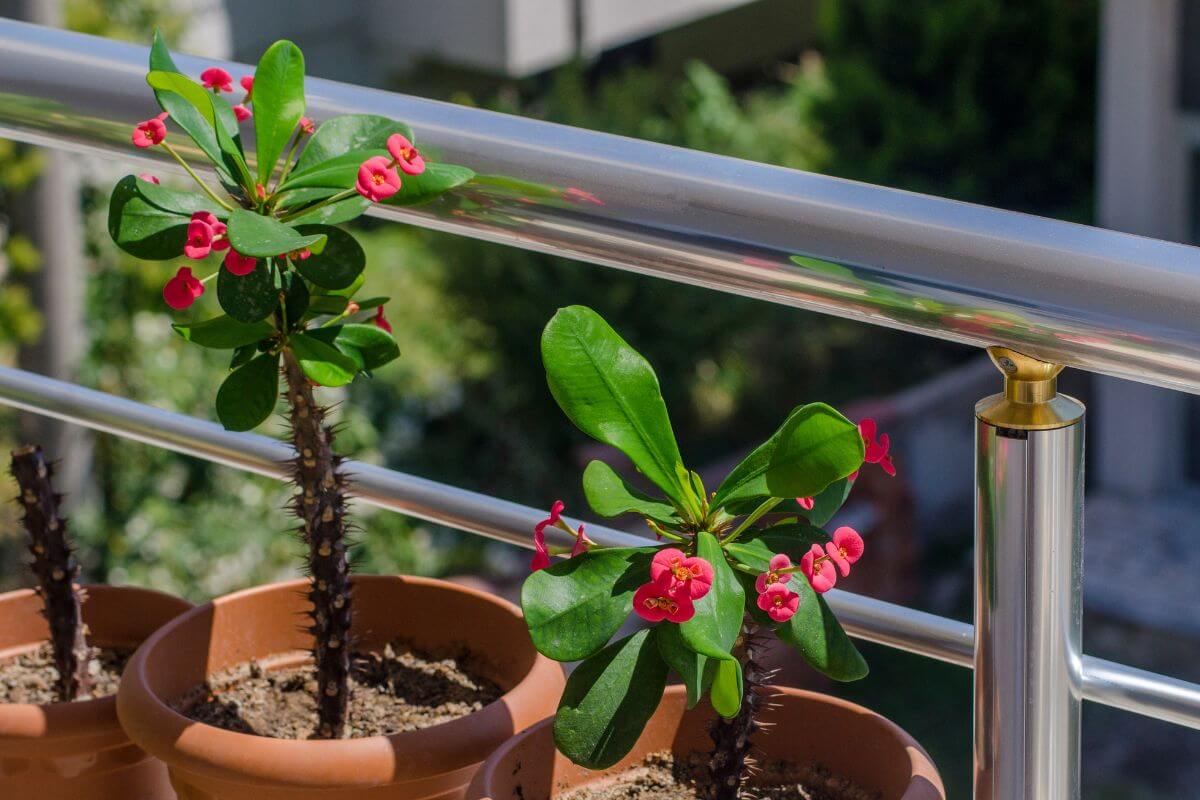
Pruning should be done at the end of the growing season. Older, fading leaves should be removed to stimulate new growth and to keep in check the shape of your plant.
Prune and trim it to create a shape and size you like. If you prefer a bushy, full shrub, feel free to prune branches. Each pruned branch should yield 2-3 new branches.
Crown of Thorns Common Plant Pests and Diseases
Pest infestations to watch for include mealybugs, scale insects, and thrips. That’s common for indoor plants.
Fungal diseases including leaf spotting and botrytis are a risk for root rot if this plant is left in soggy water. Allowing the soil bed to dry out between waterings will help prevent this.
Crown of Thorns Toxicity and Pets
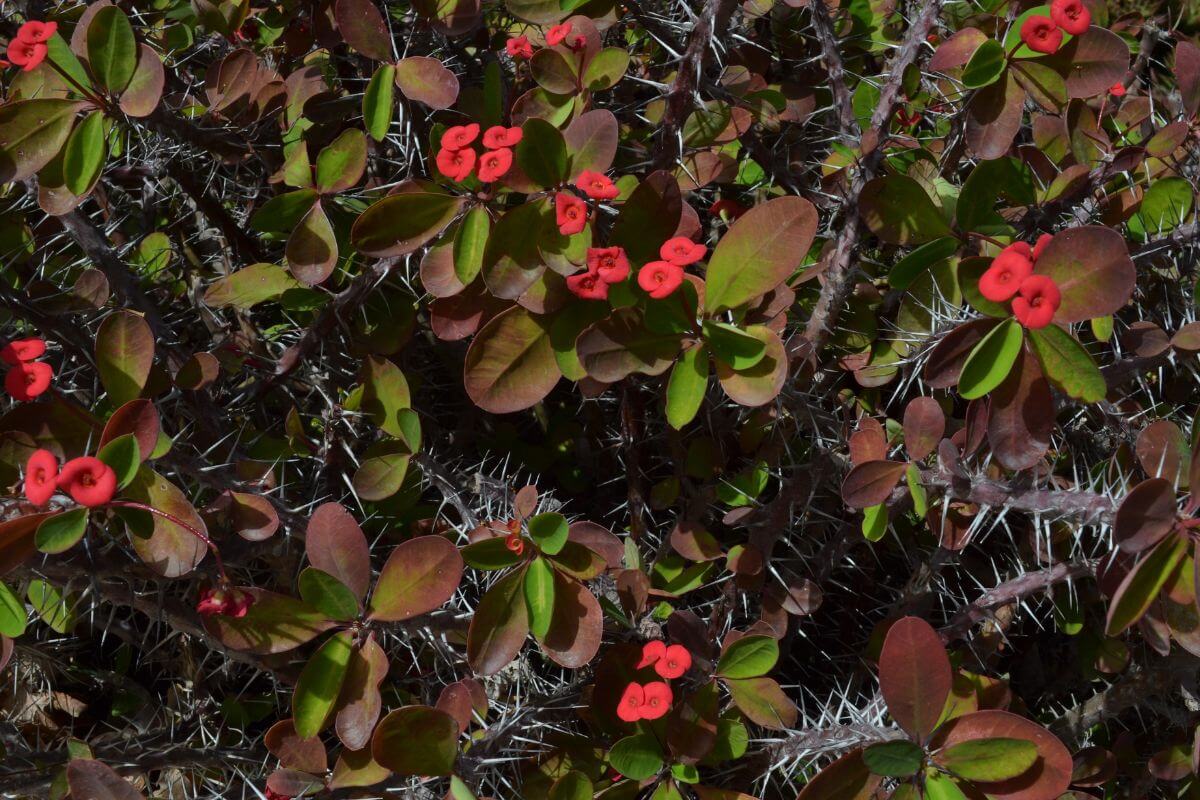
The crown of thorns plant is poisonous to dogs and to cats. Many Euphorbia genus succulents are known to be toxic. Poisoning symptoms may include skin irritation, eye irritation, and gastrointestinal problems.
If you suspect that your pet has ingested any part of a crown of thorns plant, contact your veterinarian or poison control center immediately.
Propagating the Crown of Thorns
As most crown of thorns plants are hybrids, they are not started with a seed.
To make cuttings for easy propagation:
- Wear gloves to avoid contact with the sap.
- Cut off a stem that is approximately four to six inches in length and place it in warm water for several minutes.
- Remove the cuttings from the water and lay them to dry for a few days, so that a callus forms over the wound.
- Then they can be planted in moist soil. Just make sure it’s not a soggy soil bed.
Crown of Thorns Care Final Thoughts
If you want a plant that can thrive in just about any environmental condition, the crown of thorns succulent plant is one ornamental plant for busy plant owners.
It’s adaptable, loves sun exposure, does not require particular humidity, and will reward you with beautiful vividly colorful blooms all year long.
For more houseplant care guides, check out these articles:
- Bamboo Palm Care and Grow Guide
- Angel Wing Begonia Care and Grow Guide
- Goldfish Plant Care and Grow Guide
- Lipstick Plant Care and Grow Guide
Crown of Thorns Care FAQs
Does a crown of thorns plant need full sun?
Yes, the crown of thorns plant needs direct sunlight. It prefers bright light but tolerates some shade too. Place it in an area where it gets sunlight in the morning and shade in the afternoon. The more sun, the better!
Can I cut back my crown of thorns plant?
Yes, you can cut back and prune your crown of thorns plant when its foliage starts to look tired. You’ll notice that older, faded leaves turn brownish yellow. This means that the plant is getting ready to flower again. Cut these old leaves away to get rid of dead tissue and promote fresh growth. Each pruned branch should yield 2-3 new branches.
Is the crown of thorns plant poisonous?
Yes, the crown of thorns plant is poisonous, so you’ll want to be careful when handling. If exposed, poisoning symptoms may include skin irritation, eye irritation, and gastrointestinal problems. You’ll want to be careful with them if you have pets and kids around.
Why is my crown of thorns not flowering?
Your crown of thorns might not be flowering because it’s not receiving enough sunlight or excessive watering. If you want your plant to bloom, be sure to give it plenty of light. Make sure the pot or container has well-draining potting mix, so it doesn’t become overwatered.
How fast does a crown of thorns grow?
The crown of thorns houseplant is a slow grower, but it can grow to 3-6 feet tall as an outdoor shrub. As an indoor plant, it can grow to 2 feet tall.
Why are the leaves on my crown of thorns turning yellow?
Crown of thorns plant’s yellow leaves indicate that the plant isn’t getting enough nutrients. Give it a slow-release fertilizer to help it get nutrients. Also check that it’s not being overwatered, so check for wet soil.


